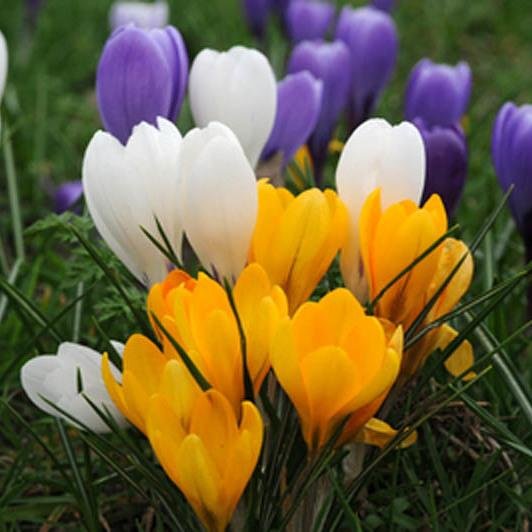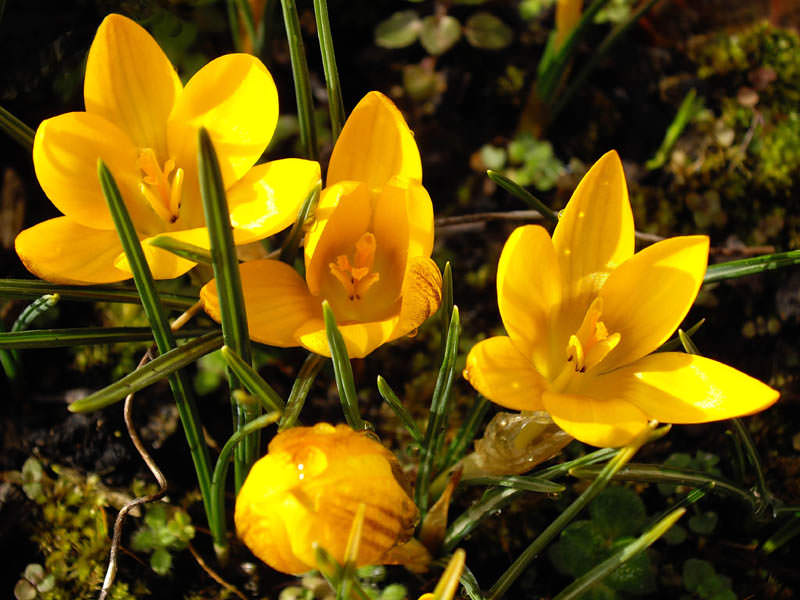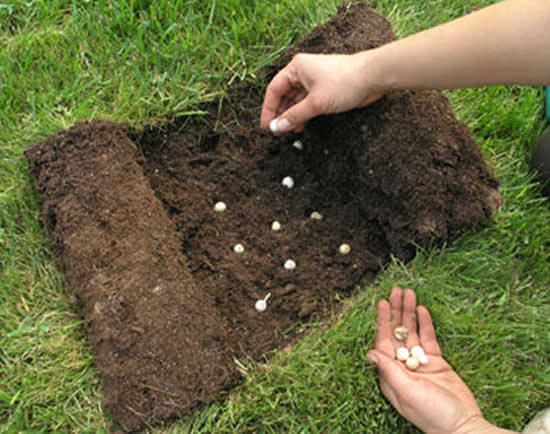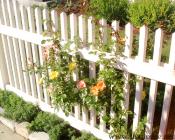Search
Login
Crocuses - species, planting and care
People have been growing crocuses for several thousand years, and not only for decorative purposes, crocuses are used in medicine, for the production of dyes and the most valuable spice in the world - saffron. To get 1 kg of spice you need 170,000 flowers of autumn crocus. Among the well-known garden perennials, crocuses occupy not the last place, this bulbous plant will decorate the garden not only in spring but also in autumn, crocuses are perfectly combined with delicate greenery of the lawn. A variety of species, delicate colors of cupped flowers and relative unpretentiousness make crocuses an indispensable decoration of the garden.
Content
- Autumn and spring crocuses, varieties
- Crocus planting in autumn or spring video
- Planting crocuses on the lawn
- Care video
- Why Crocus Does Not Bloom
Autumn and spring crocuses, varieties
Spring crocuses are primroses and begin to bloom in March, crocuses look great in rock gardens and on lawns, suitable for growing on balconies and shaded areas. Autumn crocuses give a bright spark to the garden plot, blooming in October, when most other plants have completed the flowering period.

The color of spring and autumn crocuses depends on the plant variety, white, lilac, purple, yellow, blue and pink shades are available. Spring crocus species include:
- Dutch crocus is the color of all the colors of the rainbow, there are flowers with two contrasting shades.
- Scottish, two-flowered crocus - there are also autumn-flowering varieties, white, with purple petals on the underside.
- Crocus Tomasini - a popular species of early crocuses, colors from pink to lilac, are recommended for cultivation on lawns.
- Golden crocus - different colors are available, including pure white, yellow-orange, blue, pale yellow.

Autumn crocus species:
- Saffron seed - it is from this type of crocus that saffron seasoning is obtained. The color of the petals is from blue to purple, the pistils are red.
- Narrow-leaved crocus - orange-yellow flowers, brown stripes on the underside of the petals.
- Beautiful crocus - very beautiful delicate - large purple flowers with dark stripes on the petals.
Autumn crocuses are often confused with poisonous colchicum, in connection with which it is recommended to purchase autumn varieties in specialized stores.
Crocus planting in autumn or spring
Crocuses prefer a sunny area, if you live in the south, partial shade is recommended, as there is a risk of leaf damage and drying of the bulbs from the hot sun. Crocuses love fertile, slightly acidic soil, but are generally tolerant of other types of soil.

Planting of spring crocus is carried out in the fall from September to October or early spring (during spring planting, crocuses will bloom in a year), bulbs are planted at a depth of 5 - 7 cm.The distance between bulbs is 5 cm, planting up to 10 bulbs in one hole is possible.

After planting, the soil is covered with a layer of mulch or bark. Crocus bulbs are resistant to frosts up to 20 C, if the winters are colder, you can cover the plants with bark, dry grass, cardboard for the winter, and in winter it is important that the snow covers the plants.
Another way to protect against frost is to dig in May and store the bulbs at a temperature of about 20 ° C in a dry place until the crocuses fall in the open ground in autumn.
Planting of autumn crocuses is similar to spring species, they differ only in terms of planting. Autumn crocuses are planted in August; they dig up tubers two weeks after flowering.
Planting crocuses on the lawn
Spring crocuses planted on a green lawn look attractive, a lawn with early flowers after winter becomes the main decoration of the garden. Planting dates do not change, the lawn must be in a well-lit area of \u200b\u200bthe sun, pay attention to the lawn after rain, you can not plant flowers in places where water stagnates, crocus bulbs quickly rot due to excess moisture.

The lawn, which is actively used, is not suitable for flowers, it is clear that delicate crocuses will not withstand trampling. A luxurious fertilized lawn with thick grass will also not work, the grass simply will not allow the bulbs to develop normally. Keep in mind that you cannot mow the lawn for several weeks until the first crocus leaves appear.
Crocuses are recommended to be planted in random places of 3-5 bulbs, for this, use a shovel to make a depression of 8-10 cm, after planting the bulbs, water the soil abundantly so as not to forget the place, designate it as you like. Caring for crocuses on the lawn is simple - applying organic fertilizers, careful processing of the lawn. Note that in this way tulips and daffodils are planted on the lawn, but they do not adorn the lawn as luxuriously as crocuses.
Care
Crocus, a flower that does not need special care, the bulbs are quite lacking in nutrients from the soil without extra fertilizing, unless the soil is quite fertile. Crocus bulbs are attractive to rodents such as squirrels and mice. How to protect bulbs from rodents? There are several ways to do this:
- Blood meal and chili around the plant will keep small rodents close
- Waste from the toilet of pets will also scare away intruders
- Most rodents avoid daffodils, snowdrops and onions, you can take advantage of this by planting them around crocuses.
Another important point in growing crocuses is not to remove the fallen leaves from the bush, they should overdo and nourish the plant with microelements to form flowers in the next season. Every 2-3 years, crocuses should be dug up and separated tubers, transplanted to a new place.
Why Crocus Does Not Bloom
There may be several reasons. If you live in the south, take care of timely watering, often crocuses do not bloom if there is insufficient nutrition in the soil, in this case organic fertilizing will help. Crocuses need sun, make sure that the flowers grow in a sufficiently lit place.

Sometimes rodents eat buds of crocuses, the fight with them is described above. Do not forget to transplant crocuses, perhaps the bulbs have become crowded, this usually happens in abandoned areas, when crocuses grow in one place for more than five years.





